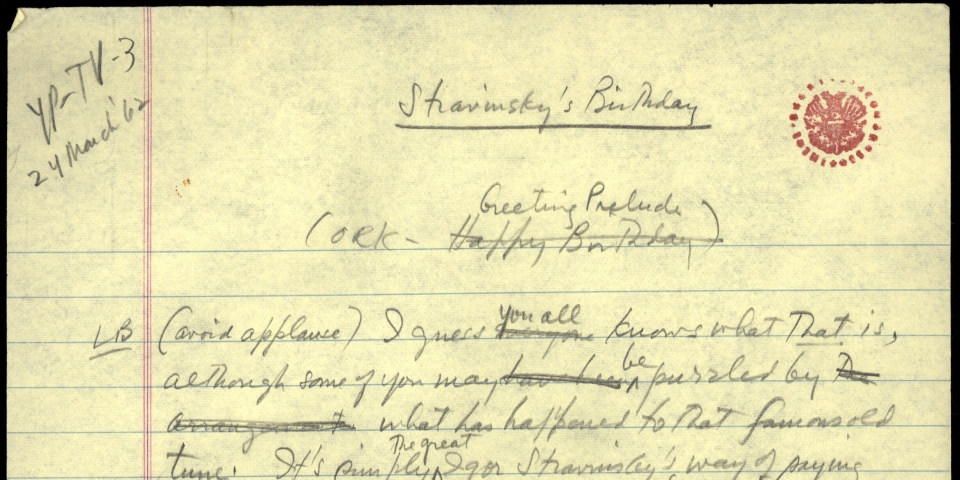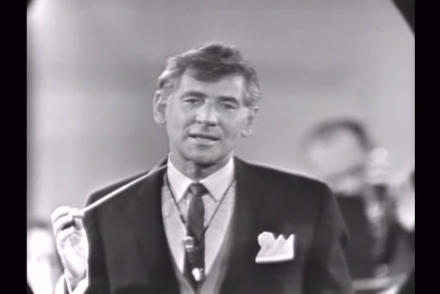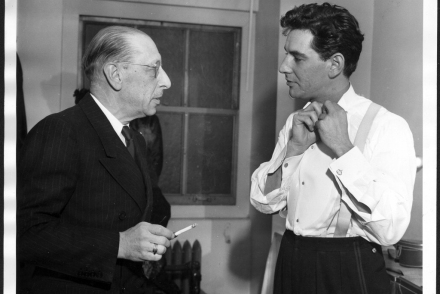Lectures/Scripts/WritingsTelevision ScriptsYoung People's ConcertsHappy Birthday, Igor Stravinsky

Young People's Concert
Happy Birthday, Igor Stravinsky
Written by Leonard Bernstein
Original CBS Television Network Broadcast Date: 26 March 1962
Did you guess what that was? What is it?
Happy Birthday all right, only it's the great Igor Stravinsky's individual way of saying Happy Birthday, in an arrangement he made a few years ago to celebrate the eightieth birthday of his great friend Pierre Monteux, the famous conductor. And so, now that Mr. Stravinsky's own eightieth birthday is coming up in June, what better way is there for us to say "Happy Birthday" to him than by playing it back to him, in his own language? But when we say "Happy Birthday" to Igor Stravinsky, as we are doing on this program, we are not only giving him our congratulations and our wishes for many more healthy productive years. We are also paying tribute, with all our respect and admiration and devotion, to the greatest composer in the world today. Now that's a big statement, but I don't think anyone will argue about it. Whatever your tastes are—romantic or classical or very up-to-date—there are always works by Stravinsky that you will love. And all these works are in a personal style and language all his own: You can never mistake that Stravinsky sound, just like the version of Happy Birthday we just heard. It's an amazing thing, this original personality he has, especially when you think of how many times he has changed his style of composing in the last fifty or sixty years, just as he has changed his country from Russia—where he was born—to France to America, where he lives now in California. He started back in Russia writing for big orchestra, brilliant, luscious, colorful music—like the ballets Firebird, Petrouchka and the world-shaking ballet The Rite of Spring. Now that was a revolutionary piece: It changed the history of music with its strange new rhythms, its barbaric grunting and howling, and its massive dissonant chords, like these—
Now everyone was shocked by that back in 1913, shocked into either wild excitement or into fury, but everyone was impressed by this new, thunderous genius. And just when they thought they had his number—a thunderer—he switched on them, with the ease of a bullfighter reversing his cape. Whoosh—and Stravinsky had a new style: Small orchestras, sharp pointy, little music, precise tricky rhythms, plus a whole new idea called neoclassicism, which means a new look at old classic styles. That is, he was suddenly writing music that reminded one faintly of old Handel, or of Mozart, or of Bach as in these few bars from his concerto for small orchestra called Dumbarton Oaks.
Quite a change isn't it, from the howling of The Rite of Spring? But then came the biggest switch of all, only in these last ten years. You see, since the beginning of our century there has been a new kind of music developing in the world, sometimes called atonal music, sometimes twelve-tone music or serial music. Now Stravinsky had always written the exact opposite of this kind of music, but lo and behold in the last ten years he has fooled the bull again, with a swish of the cape again, and begun to write his own kind of serial music, or atonal music, or whatever you want to call it. Just listen to these bars from his latest ballet, called Agon.
Now that's really a switch. In fact, Stravinsky has now become the world leader of this kind of music. And so it is this king Igor that we salute today, the ever-changing, ever-new, ever-young Igor who at the age of eighty, imagine eighty, is still handing out the biggest surprises in the world of music.
And just to help you understand what we mean by "surprises," let's jump for a minute from music to painting and think of the greatest painter in the world today, who is Picasso of course, who also is in his eighties, and who also holds some kind of world record for changing from one style to another. Just look at these three pictures. Here is a drawing of a woman by Picasso, normal enough, made in the year 1905. Now here is one dated 1911, also of a woman, if you can believe it. Can you believe it's by the same man who painted the first picture? And here is a woman, believe it or not, also by Picasso, painted in 1945. They might be three completely different painters. How about that for fooling the bull!
And this is exactly what Stravinsky has done, only in music through musical notes. I wish we had time today to give you a sample of all his different styles and moods, but then you wouldn't get to hear any one of his works whole. So, to honor him today on his birthday, we have decided to play for you one masterpiece of his, and play all of it—the famous ballet Petrouchka. We're going to play Petrouchka not only because it's exciting music, but especially because it is so close to young people and to children. Stravinsky himself has said that his music is loved and understood best by children; I don't know if this is strictly true, but it is certainly true of his Petrouchka, which takes us into the world of dolls and puppets, with all the imagination and fantasy that go with it. But what makes Petrouchka even more special is that the story of the ballet tells of two worlds at once—the real world of people like us and the unreal world of puppets who come to life, so that the doll-world and the human-world almost become one and the same.
The story of Petrouchka is based on an old Russian legend, but I'm not going to tell you the whole story at once because I don't want to give away the surprise ending until it comes. Instead I will tell you about each one of its four scenes as we go along. First scene: Imagine yourselves at a fair in a great crowded square of St. Petersburg, Russia, over a hundred years ago, long before that city got its modern name of Leningrad. It is carnival time, a bright cold day, and everyone in town has turned out for a good time: Old and young, rich and poor, drunk and sober, they are all crowding around the booths and into the carousel and onto the swings. The music is all festivity and bustle.
In one part of the square, a bunch of the boys are whooping it up with a Russian folksong:
And over in another part of the square an organ grinder is playing a waltz while a young girl dances to it:
While across the way another pretty girl is waltzing to a music box:
Then we hear the two waltzes together:
Then, suddenly, two drums announce that a puppet show is going to begin and the crowd surges around the puppet theatre in the middle of the square. Now this theatre is run by a mysterious old Oriental-type magician, whom Stravinsky describes like this:
This old magician opens the curtain of his little theatre, revealing three life-size puppets: First, a beautiful Ballerina in her ballet dress; and a fierce-looking African prince, or Moor, as he's called, all decked out in silks and velvets with jewels in his turban; and last of all, little Petrouchka (which, as you can guess, is a Russian nickname for Peter)—Petrouchka, a sweet, pathetic, awkward boy, rather like Pinocchio. While the orchestra plays spooky music, the old magician makes some hocus pocus at the three puppets, and he plays to them on his magic flute, and suddenly, one—
two—
three—
They magically come to life. And to the amazement of the crowd they begin to dance, under their own steam.
And with this famous dance, the first scene ends. But for the story of Petrouchka himself, it is only the beginning as we will see. Now here is the entire first scene of Petrouchka.
We left Petrouchka dancing, along with the Ballerina and the Moor, before an astonished crowd in the square at St. Petersburg. But now, with the second scene, we leave the square and the crowd and all of what we call "real life," and move into the world of the puppets themselves—that is into their real world, backstage in the puppet theatre, where each of them has his own little room to live in. Don't forget that the moment these three dolls received life from the magician's flute, they also acquired all the human feelings and passions that go with life. And Petrouchka has the most sensitive feelings of the three. He is lonely, funny-looking, awkward, and madly in love with the beautiful Ballerina. But, of course, she won't have him: She prefers his rival, the fierce, foolish Moor, who is richer and bigger and fancier. Petrouchka naturally is desperate. As we move toward his room in the little theatre, to the accompaniment of those drums,
we hear little doll-like screams. They are Petrouchka's cries, of course, as he flings himself about his room, sobbing.
That is what this whole scene is about—the agony of Petrouchka. In it you will hear every imaginable kind of sobbing, weeping, shrieking, wailing, and beating the walls. It is heart-breaking music: Just listen to Petrouchka's theme on the two clarinets, with the bassoon against them sobbing its heart out:
Isn't that a weird and wonderful sound? And do you know what makes it so special? Our old friend bitonality—remember that hard word from our earlier programs this season? Bitonality, music played in two different keys at once. You see, one clarinet is playing in one key, C major:
and the second clarinet is in another key, F-sharp:
And together they make that special sound that has become the most famous example of bitonality in all music. In fact, musicians always refer to this combination of C major and F-sharp as the "Petrouchka sound."
Isn't that wonderful? And when Petrouchka goes really mad with suffering, his theme sounds like this:
Well, I guess that's about all you have to know about this short but high-powered second scene, of Petrouchka, which is a picture of Petrouchka alone in his room.
The drums tell us that we are moving into Scene 3, which is in the Moor's room. Now the Ballerina, at one point, pops in to visit him, playing on a toy trumpet, and the Moor dances a sentimental little waltz with her—a sort of dolls' love scene. And in the middle of it we suddenly hear Petrouchka's theme, coming closer and closer until finally he breaks into the room in a fit of jealousy. There is a chase around the room, the Ballerina faints, and at the climax the Moor grabs poor little Petrouchka and boots him out with a painful series of whacks, which I'm sure you'll all recognize. Here we are in Scene 3: In the Moor's room.
Poor Petrouchka! He doesn't stand a chance in this cruel real world he's been brought into. And at this point, we too are brought back to our real world, in the fourth and last scene we're taken back to the great square of St. Petersburg, where we started, where the carnival fun is at its height. By now it is late in the day, the lights are beginning to come on, and the air is thick with sounds and smells and human bodies everywhere. This marvelous final scene is like a huge painting of Russian life, full of lusty Russian folktunes and foot-tapping rhythms. And into the midst of all this wild hilarity, runs poor, half-crazy Petrouchka, fleeing for his life from the wicked Moor.
Somehow they've both broken out of their world backstage and are running loose in the square. You see how the two worlds have gotten mixed up together into one? So here comes Petrouchka, with the Moor in hot pursuit. The crowd stops dead in its tracks, seeing this incredible sight, and it is only a moment before the Moor catches up with Petrouchka and—I'm sorry to say—kills him with one blow of his sabre. Petrouchka falls and dies in the snow, with everyone looking on in horror. At this very second in hobbles the old magician who started the whole thing by bringing his puppets to life in the first place. But the old man simply picks up Petrouchka's lifeless body, and shows it to the crowd. "Look," he says, "it's only a doll. Rags, sawdust, stuffing, and a wooden head." And indeed, it is only a doll. So everyone quietly goes home. It is now dark; it begins to snow. Finally, the stage is empty except for the weird old magician, dragging his broken doll away. But at that moment of near-silence, two trumpets suddenly pierce the air like flashes of lightning, playing Petrouchka's theme,
and there, on the roof of the little theatre, we see Petrouchka's ghost, laughing away at the old guy, thumbing his nose at him. The magician is terrified, drops the doll, and runs away. Silence. Absolute emptiness. Just a tiny, faint echo of the accordion-like music hangs in the air. And then, a few vague plucked notes in the strings, and the ballet is over, leaving us hanging in suspense between one world and the other. Did all this really happen? Was that Petrouchka's ghost up there, or was it the real Petrouchka? Or is the real Petrouchka, after all, only that broken hunk of rags and stuffing, which was made real to us for a few minutes by the magic of Stravinsky's great art?
END
© 1962, Amberson Holdings LLC.
All rights reserved.
Watch a video excerpt of "Happy Birthday, Igor Stravinsky"

Bernstein with composer, Igor Stravinsky, 1946. Photographer: Ben Greenhaus.  https://www.loc.gov/item/lbphotos.46a001/
https://www.loc.gov/item/lbphotos.46a001/